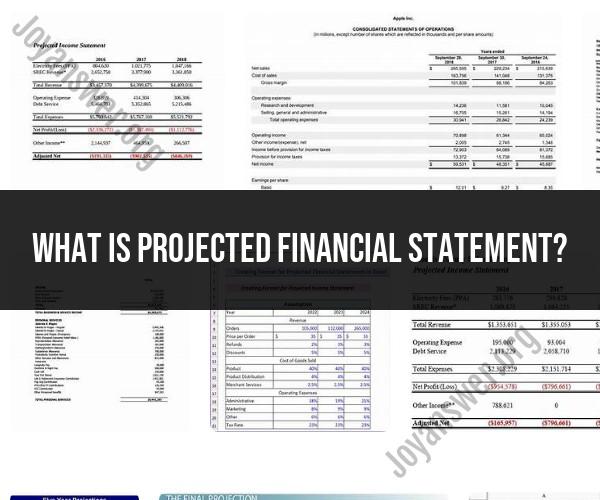What is projected financial statement?
A projected financial statement, also known as a forecasted financial statement or pro forma financial statement, is a financial statement that presents an organization's expected financial performance and position for a future period. These statements are typically prepared to aid in financial planning, budgeting, and decision-making. Projected financial statements are essential tools for businesses, investors, and creditors to assess the potential financial outcomes of various scenarios and make informed decisions.
There are three primary types of projected financial statements:
Projected Income Statement (Profit and Loss Statement): This statement provides an estimate of a company's revenue, expenses, and profits for a specific future period, typically on a monthly, quarterly, or annual basis. It helps businesses anticipate their expected profitability over time and evaluate the impact of various revenue and expense assumptions.
Projected Balance Sheet: A projected balance sheet outlines the expected financial position of a company at a future date. It includes assets, liabilities, and equity, providing insights into a company's financial health, liquidity, and solvency. The balance sheet helps assess how changes in assets and liabilities will affect the organization's financial stability.
Projected Cash Flow Statement: The projected cash flow statement forecasts the expected cash inflows and outflows for a given period. It helps organizations manage their cash resources effectively, plan for capital expenditures, and ensure they have sufficient liquidity to meet their obligations.
Key purposes and uses of projected financial statements include:
Financial Planning: Businesses use projected financial statements to set financial goals, create budgets, and plan for future growth or expansion.
Investor Decision-Making: Investors use projected financial statements to assess the potential return on investment and risk associated with a particular venture or investment opportunity.
Credit Analysis: Creditors and lenders use these statements to evaluate a company's creditworthiness and determine whether to extend credit or approve loans.
Scenario Analysis: Organizations can create multiple sets of projected financial statements to explore various scenarios and assess the impact of different assumptions on their financial performance.
Strategic Decision-Making: Executives and managers use projected financial statements to make informed decisions about product launches, cost-cutting measures, and other strategic initiatives.
It's important to note that the accuracy of projected financial statements depends on the quality of the assumptions and data used in their preparation. Assumptions related to revenue growth, expenses, economic conditions, and other factors can significantly impact the reliability of the projections. Therefore, businesses and financial analysts should be diligent in their data gathering and modeling processes when creating projected financial statements.
Projected Financial Statements: Understanding Future Financial Projections
Projected financial statements are estimates of a company's future financial performance. They are typically created for a period of three to five years into the future. Projected financial statements include the following:
- Projected income statement: This statement shows the company's estimated revenue and expenses for the future period.
- Projected balance sheet: This statement shows the company's estimated assets, liabilities, and equity for the future period.
- Projected cash flow statement: This statement shows the company's estimated cash inflows and outflows for the future period.
Projected financial statements are important for a number of reasons. They can help businesses to:
- Make informed decisions about future investments and expenditures.
- Identify and mitigate potential financial risks.
- Set realistic goals and objectives.
- Attract investors and lenders.
Financial Forecasting: Creating Projected Financial Statements
There are a number of different methods that can be used to create projected financial statements. The most common method is to use historical financial data as a starting point. This data can be adjusted to reflect factors such as expected changes in sales, costs, and market conditions.
Another method of creating projected financial statements is to use industry benchmarks. Industry benchmarks are data that shows the average financial performance of companies in a particular industry.
Once a company has created projected financial statements, it is important to review them regularly and make adjustments as needed. This is because the future is uncertain and there will always be factors that could impact the company's financial performance.
Financial Planning Tools: The Importance of Projected Financial Statements
There are a number of financial planning tools that can be used to create and analyze projected financial statements. These tools can help businesses to:
- Automate the process of creating projected financial statements.
- Perform sensitivity analysis to see how changes in different factors, such as sales and costs, impact the company's financial performance.
- Generate reports and charts that make it easy to understand and analyze projected financial statements.
Projected financial statements are an essential tool for financial planning. By using projected financial statements, businesses can make informed decisions about their future and improve their chances of success.
Here are some additional benefits of using projected financial statements:
- Improved decision-making: Projected financial statements can help businesses to make better decisions about resource allocation, pricing, and marketing strategies.
- Increased accountability: Projected financial statements can help businesses to stay on track and achieve their financial goals.
- Reduced risk: Projected financial statements can help businesses to identify and mitigate potential financial risks.
- Improved communication: Projected financial statements can help businesses to communicate their financial plans to stakeholders, such as investors and lenders.
Overall, projected financial statements are an essential tool for any business that wants to improve its financial performance and achieve its long-term goals.











